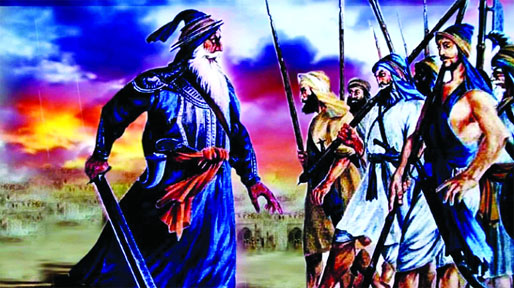
Guru Gobind Singh’s leadership marked the transformation of Sikhism from a primarily spiritual movement into a martial and political force. This transition was not merely about militarization but represented a comprehensive restructuring of the Sikh faith to respond to the socio-political realities of the time. This section explores the evolution of Sikhism under Guru Gobind Singh, the principles of saint-soldierhood, key battles, and the enduring legacy of the warrior ethos in Sikhism.
Context of Transformation: Historical Challenges
Religious Persecution in India:
– The late 17th century saw widespread persecution under Mughal Emperor Aurangzeb, who sought to impose Islamic orthodoxy.
– Sikhs, Hindus, and other non-Muslim communities faced forced conversions, destruction of places of worship, and suppression of cultural practices.
Legacy of Guru Hargobind:
– Guru Gobind Singh inherited the ideology of Miri-Piri established by Guru Hargobind, blending spiritual enlightenment with temporal strength.
– Guru Hargobind had already begun the militarization of Sikhism by creating the Akal Sena (army) to protect the oppressed.
Martyrdom of Guru Tegh Bahadur:
– The execution of Guru Gobind Singh’s father, Guru Tegh Bahadur, for defending religious freedom served as a turning point.
– It reinforced the need for Sikhs to adopt a defensive and proactive stance against oppression.
Rise of Banditry and Local Tyranny:
– Beyond Mughal persecution, local chieftains and landlords often exploited peasants and lower-caste groups.
– Guru Gobind Singh envisioned Sikhism as a force to liberate society from these injustices.
Philosophy of Saint-Soldierhood
Guru Gobind Singh introduced the concept of the Sant-Sipahi, or saint-soldier, emphasizing a balance between spiritual devotion and martial readiness.
Spiritual Foundation:
– Sikhs were encouraged to meditate on Naam (God’s Name) and uphold the principles of humility, compassion, and selflessness.
– The warrior ethos was rooted in the defense of righteousness and justice, not in aggression or conquest.
Martial Responsibility:
– Every Sikh was taught to see themselves as a protector of the weak and a defender of the faith.
– Martial training, including the use of swords, bows, and horses, became integral to Sikh life.
Equality and Justice:
– The saint-soldier was also a social reformer, challenging caste-based discrimination and advocating for human rights.
Inspiration from Mythology and History:
– Guru Gobind Singh drew inspiration from Hindu epics like the Mahabharata and Ramayana, and Islamic traditions of chivalry, blending these influences into a unique Sikh warrior philosophy.
Formation of the Khalsa
The founding of the Khalsa in 1699 was central to the transformation of Sikhism into a warrior faith.
Institutionalizing Martial Training:
– The Khalsa order emphasized discipline, bravery, and self-sacrifice.
– Initiates were trained in the art of war and imbued with spiritual teachings.
Democratic Leadership:
– The concept of the Panj Pyare (Five Beloved Ones) reflected Guru Gobind Singh’s commitment to collective decision-making.
– The Khalsa was a brotherhood bound by shared principles, transcending caste and class divisions.
Code of Conduct (Rehat Maryada):
– Khalsa Sikhs were required to wear the Five Ks, embodying spiritual and martial values.
– They pledged to fight against tyranny and protect the oppressed, regardless of religion or background.
Military Campaigns of Guru Gobind Singh
Guru Gobind Singh personally led numerous military campaigns to defend Sikhism and resist Mughal oppression.
Battle of Bhangani (1688):
– The first major battle fought by Guru Gobind Singh against local hill chieftains who resented his growing influence.
– It established his reputation as a capable military leader.
Battle of Nadaun (1691):
– Guru Gobind Singh allied with Raja Bhim Chand of Bilaspur to defeat Mughal forces.
Defensive Strategies at Anandpur Sahib:
– Anandpur Sahib became a fortress of resistance, symbolizing Sikh resilience.
– Guru Gobind Singh repelled multiple attacks by combined Mughal and hill chieftain forces.
Battle of Chamkaur (1704):
– A pivotal moment in Sikh history, where Guru Gobind Singh and his forces valiantly defended against overwhelming Mughal forces.
– The Guru’s two elder sons, Ajit Singh and Jujhar Singh, were martyred in this battle, epitomizing the spirit of sacrifice.
Battle of Muktsar (1705):
– The Guru’s forces, though outnumbered, achieved a symbolic victory, demonstrating their unyielding spirit.
– The battle is commemorated as a testament to Sikh valor and unity.
Transformation of Sikh Institutions
Guru Gobind Singh restructured Sikh institutions to reflect the warrior ethos and ensure the community’s self-sufficiency.
Fortification of Sikh Centers:
– Anandpur Sahib and other towns were developed into centers of spiritual learning and martial training.
Economic Self-Reliance:
– Sikhs were encouraged to contribute to the community treasury, enabling the establishment of langars (community kitchens) and the maintenance of armed forces.
Appointment of Successors:
– Before his death, Guru Gobind Singh declared the Guru Granth Sahib as the eternal Guru of the Sikhs, ensuring spiritual continuity.
– Leadership was decentralized, with the Khalsa assuming collective responsibility.
Enduring Legacy of the Warrior Faith
Guru Gobind Singh’s transformation of Sikhism into a warrior faith has left a lasting legacy.
– The martial ethos inspired later Sikh leaders, including Banda Singh Bahadur and Maharaja Ranjit Singh, in their struggles against tyranny.
– Sikh soldiers played crucial roles in global conflicts, earning respect for their bravery and discipline.
Modern Relevance:
– The principles of saint-soldierhood guide Sikhs in addressing contemporary challenges, from social injustice to humanitarian crises.
Cultural Identity:
– The warrior spirit is celebrated through Sikh festivals, martial arts like Gatka, and the continued reverence for the Five Ks.
Guru Gobind Singh’s Military Strategy
Guerrilla Warfare:
– The Guru employed hit-and-run tactics, using the terrain to his advantage.
– He avoided direct confrontations with larger forces, striking strategically to weaken the enemy.
Use of Fortresses:
– Fortresses like Anandpur Sahib and Lohgarh were strategically located and well-fortified to withstand prolonged sieges.
Unity and Morale:
– Guru Gobind Singh fostered a sense of brotherhood and shared purpose among his warriors.
– His personal involvement in battles inspired loyalty and courage.





Be the first to comment